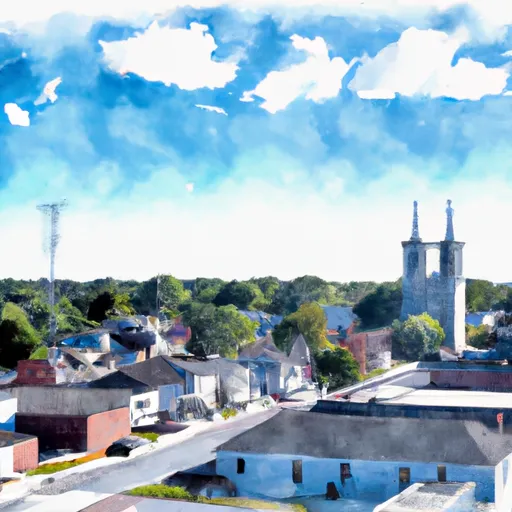-
 Snoflo Premium
Snoflo Premium
Get unlimited access to all our content
With no Ad interruptions! - Start Your Free Trial Login with existing account
Tylerton
Eden Index
Climate
9.8
•
Recreation
4.5
•
Community
0.8
•
Safeguard
5.7/10

Tylerton is a small and picturesque community located on Smith Island, Maryland. Situated in the Chesapeake Bay, Tylerton experiences a humid subtropical climate characterized by hot and humid summers and mild winters. Summers bring average temperatures in the mid-80s Fahrenheit (29°C), while winters average around the mid-40s Fahrenheit (7°C).
Hydrologically, Tylerton is surrounded by the Chesapeake Bay and the Tangier Sound. This unique location offers opportunities for fishing, crabbing, and boating, as well as wildlife observation. Visitors can explore the marshes and wetlands, home to a diverse array of bird species and other wildlife.
Outdoor recreation in Tylerton is primarily focused on water activities. The calm waters of the bay provide the perfect setting for kayaking and paddleboarding, allowing visitors to admire the beautiful scenery and perhaps catch a glimpse of the iconic Chesapeake Bay blue crab. Additionally, Tylerton is a popular destination for recreational fishing, with anglers able to pursue species such as striped bass, flounder, and bluefish.
Overall, Tylerton, Maryland offers a serene and scenic environment for outdoor enthusiasts, providing ample opportunities to enjoy the area's unique hydrology and natural beauty.
What is the Eden Index?
The Snoflo Eden Index serves as a comprehensive rating system for regions, evaluating their desirability through a holistic assessment of climate health, outdoor recreation opportunities, and natural disaster risk, acknowledging the profound impact of these factors on livability and well-being.
Climate Health Indicator (CHI): 9.8
Tylerton receives approximately
1116mm of rain per year,
with humidity levels near 76%
and air temperatures averaging around
15°C.
Tylerton has a plant hardyness factor of
8, meaning
plants and agriculture in this region tend to thrive here all year round.
By considering the ideal temperature range, reliable water supplies, clean air, and stable seasonal rain or snowpacks, the Climate Health Indicator (CHI) underscores the significance of a healthy climate as the foundation for quality living.
A healthy climate is paramount for ensuring a high quality of life and livability in a region, fostering both physical well-being and environmental harmony. This can be characterized by ideal temperatures, reliable access to water supplies, clean air, and consistent seasonal rain or snowpacks.
Weather Forecast
Streamflow Conditions
Upper Chesapeake
Area Rivers
Upper Chesapeake
Snowpack Depths
Upper Chesapeake
Reservoir Storage Capacity
Upper Chesapeake
Groundwater Levels
Recreational Opportunity Index (ROI): 4.5
The Recreational Opportunity Index (ROI) recognizes the value of outdoor recreational options, such as parks, hiking trails, camping sites, and fishing spots, while acknowledging that climate plays a pivotal role in ensuring the comfort and consistency of these experiences.
Access to outdoor recreational opportunities, encompassing activities such as parks, hiking, camping, and fishing, is crucial for overall well-being, and the climate plays a pivotal role in enabling and enhancing these experiences, ensuring that individuals can engage in nature-based activities comfortably and consistently.
Camping Areas
| Campground | Campsites | Reservations | Toilets | Showers | Elevation |
|---|---|---|---|---|---|
| Kiptopeke State Park | None | 30 ft | |||
| Janes Island State Park | 100 | 4 ft |
Nearby Ski Areas
Catastrophe Safeguard Index (CSI):
The Catastrophe Safeguard Index (CSI) recognizes that natural disaster risk, encompassing floods, fires, hurricanes, and tornadoes, can drastically affect safety and the overall appeal of an area.
The level of natural disaster risk in a region significantly affects safety and the overall livability, with climate change amplifying these risks by potentially increasing the frequency and intensity of events like floods, fires, hurricanes, and tornadoes, thereby posing substantial challenges to community resilience and well-being.
Community Resilience Indicator (CRI): 0.8
The Community Resilience Indicator (CRI) recognizes that education, healthcare, and socioeconomics are crucial to the well-being of a region. The CRI acknowledges the profound impact of these elements on residents' overall quality of life. By evaluating educational resources, healthcare accessibility, and economic inclusivity, the index captures the essential aspects that contribute to a thriving community, fostering resident satisfaction, equity, and social cohesion.

